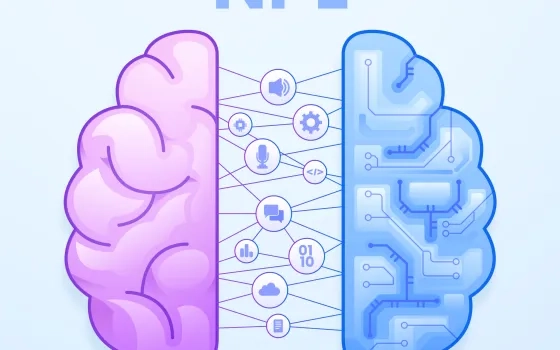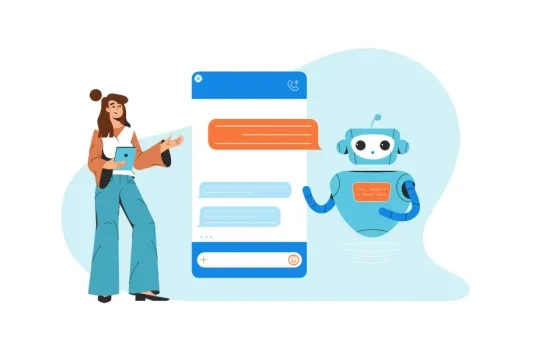Introduction
NLP (Natural Language Processing)technology is emerging as an amplifier in harnessing AI development in the real world. The role of NLP technology in Artificial intelligence development is a sure solid solution for businesses that are actively looking for AI solutions to analyze a large corpus of their unstructured business data.
The power duo, AI NLP has now entered our daily lives by powering search engines and enabling search commands. Some beneficial NLP examples include AI-powered devices like Alexa, AI chatbots, and language translation. And do you remember the buzz that generative AI tools created with their advent? That’s NLP for AI development in action! In the Blogpost we will dive into the step-by-step process, tools, and practices for implementing NLP in AI development projects. But before that, let's steer the basic concepts clear.
Understanding NLP: How Does NLP Work?
For all those who want to understand NLP fundamentals, it's time to dive deeper. According to IBM, NLP is a subfield of AI and computer science technologies that aim the machines to comprehend human information, and analyze, and interpret data. The technology seeks to process queries and respond in a human-like language with an interactive conversational tone.
Machine learning advancements like neural networks and data analytics powered by AI solutions have further advanced to a ground-breaking edge. The evolution of these technologies has helped researchers come up with accurate models that understand the context awareness of the topic, underlying emotions, and intentions for prompting a particular query.
NLP comprises the following components for an elevated capability.
- Computational linguistics
- Machine learning
- Deep Learning
In tandem, these advancements have directly resulted in the accelerated growth of AI developments. Thanks to Machine learning algorithms, NLP has allowed AI developers. It makes developing complex AI chatbots and voice-activated assistants easier. They also respond to user prompts quite accurately.
Demystifying the Role of NLP for AI Developments
NLP technology is the flag bearer when it comes to helping machines with computer-enabled systems to learn, process, and comprehend information in a way that the user wants. The ability to comprehend information and draw irrelevant insights is crucial for the core of AU developments. Let us understand how.
Automated Customer Support Services
The role of NLP has empowered AI developments by streamlining human interactions and communication seamlessly. It has empowered businesses in ways one cannot imagine. Providing 24/7 virtual assistance is a crucial facet that emphasizes responding to user queries instantly. NLP provides a valuable way to learn about the pain areas and concerns of consumers further improving their range of products or services.
Valuable Customer Data
For businesses across the globe, valuable data from customers can help them draw insights in real-time. This helps brands serve their customers in a much more accurate manner. Furthermore, it helps brands learn about evolving customer trends and preferences.
The e-commerce industry can gain significant insights into what customers think about their brands. NLP helps the AI system process a large number of datasets and customer information from social media platforms to draw human-like data-driven insights.
Sentiment Analysis and Opinion Analysis
NLP allows AI-enabled systems and machines to analyze parameters underlying intentions and hidden emotions behind a user prompt. By conducting sentiment analysis, these systems gain context awareness and other parameters hidden intentions, and underlying emotions. This helps the machines learn about user perception to improve their offerings.
Text Summarization
NLP can grasp large volumes of information into digestible information. It can comprehend gallons of datasets deriving the relationship between different datasets and their importance. These help in deriving meaningful summaries from a set of information helping humans understand what the machines are trying to represent. Also, Using NLP techniques teh AI algorithms can enable tasks like Data extraction and content moderation extracting the necessary information from a large dataset, and filtering inappropriate content accordingly.
Personalized Recommendations Systems
Content classification is a powerful technique enabled by NLP in AI developments. By segmenting user-generated content, AI NLP technology can deliver personalized content based on user preferences. For example, an e-commerce app can create personalized experiences by making custom recommendations. Moreover, it helps brands run targeted advertisements aligned with user preferences.
7 Solid Ways to Implement NLP into the AI Development Projects
Now that we know how NLP techniques can contribute to impacting Machine learning and Deep learning models for an accurate outcome. Chatbots, data analytics tools, content generation tools, etc have revolutionized business operations. However, implementing NLP into your AI system needs comprehensive expertise from your side. You can collaborate with a professional AI development company with an experienced team for a seamless implementation of NLP into AI Development projects.

Image Courtesy: GeeksforGeeks
-
Define AI NLP Use Cases
This is the most understated yet crucial step. Defining the AI use cases allows organizations to learn what business operations AI/ NLP can empower. Defining the purpose for enabling business objectives can carve a smooth path for implementing NLP for AI developments. These AI NLP use cases include:
- AI-powered Chatbots
- Content Extraction and summarization
- Content Moderation
- Spam detection
- Enabled voice-search commands
-
Collect and Prepare Data
Another important step is collecting data from important sources like emails, social media platforms, and websites. Gathering quality data enables accurate NLP processing. Opt for powerful Web scraping tools like Selenium, and Scrappy with third-party API integrations like Google News API, and Twitter APIs, each with its distinctive capabilities. You can also create a custom API to seamlessly integrate NLP into your AI applications.
Once your relevant data is gathered you can get it ready for the preprocessing phase. Also, Effective techniques for this process include tokenization, Data cleaning, and normalization to segment the text into smaller pieces of words and phrases to comprehend the meaning behind them.
-
Extract the AI Features
Post data cleaning process, transform the data into numerical value to feed it into machine learning models. Implementing contextual embeddings using models like BERT, GPT, and Roberta would be of great importance. Such models allow machines to comprehend the word's meaning and its association in a sentence. Also, evaluate how often a particular word appears in the text document.
Some of the important tools for feature extraction include word embeddings and TF-IDF vectorization. These tools convert texts into numeric values using inverse frequency Documents.
-
Perform Rigorous Training On The NLP Model
After the data preprocessing and cleaning, you can feed the data and code to train the NLP model. You can embrace techniques like RNN(Recurrent Neural networks) and transformers to conduct sentiment analysis and machine translation.
For example, Word2Vec is an impactful AI algorithm developed by Google that uses neural networks to show the relationship between the words and from a corpus data text.
Part-of-speech tagging is an NLP technique that labels words with a noun, adjective, or verb to understand the grammatical structure of a sentence and the ability to comprehend the placement of each word in a sentence.
GloVec (Global word Vectorization ) developed by Stanford uses a technique of matrix factorization to produce relations between different word vectors. Transformers is an effective neural network architecture with a significantly advanced NLP by enabling the processing of words in a parallel format rather than choosing a sequential platform. Hence, it helps in gaining better word context awareness.
Use robust AI NLP tools such as TensorFlow, PyTorch, and Keras framework-powered Python has pre-trained models enabling NLP tasks into your NLP applications. Moreover, pre-trained NLP frameworks such as BERT (Bidirectional Encoders Representations form Transformer), Generative pre-trained Transformer, and 3 Hugging Face encapsulate various NLP tasks for different use cases and business objectives.
-
Evaluate the performance of the NLP Model
Constantly evaluate the performance of the NLP model by using techniques such as sequence-to-sequence models. Analyze how well the NLP model responds to the user queries and intended questions. Learn how the model reciprocates statistical information. Evaluate the extrinsic factors such as sentiment analysis, machine translation, and context awareness.
-
NLP Model Deployment
In this step, you can deploy the NLP model into larger AI applications. The process includes using APIs for the NLP models to interact with other parts of the AI applications. You can also use containerization techniques to deploy AI applications into different environments. Furthermore, Techniques like Pruning and quantization reduce the model size while deploying it on mobile applications.
-
Continuously Monitoring and Model Refinements
After the model deployment, it becomes ready to serve its purpose. However, it becomes equally important to receive valuable feedback from users. The feedback helps make significant refinements to the NLP model and improvisations. By iterating into newer versions, you can deploy NLP models that generate more accurate responses serving the user context.
In a Nutshell!
To sum up, natural language processing is emerging as an underlying infrastructure to enhance artificial intelligence developments. For businesses, NLP is a lucrative tool that allows for amplifying the outcomes of AI. AI NLP has some of the most successful use cases including AI chatbots, machine translation, and sentiment analysis. To reap maximum benefits from this power-packed duo, you need a skilled AI development backing your efforts for an innovative AI solution.




















